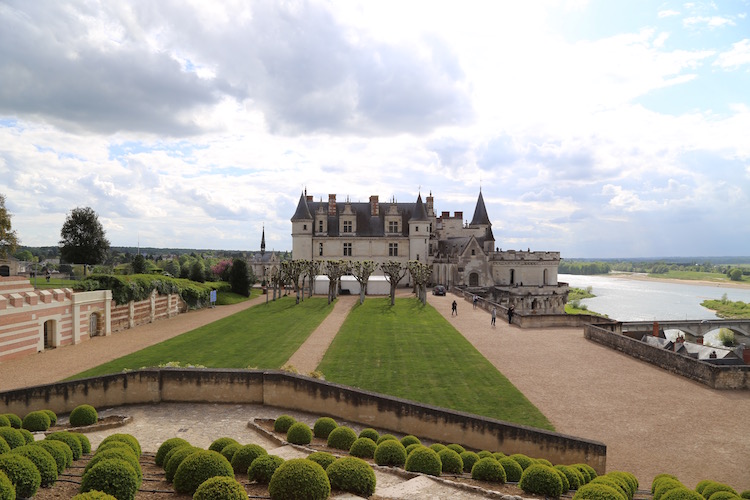I am not a historian, but I do love history. Part of the fun of visiting France is learning about its rulers and the magnificent structures they built and inhabited. French history has so much drama and intrigue. The more you see, the more certain names and timelines stick in your head. You’ve probably heard of Louis XIV, the Sun King and the ill-fated Marie-Antoinette, but have you heard of François I and Henri IV?

François I
François I ruled from 1515 until 1547. A great patron of the arts, François or Francis, sparked the French Renaissance by bringing Italian Renaissance artists to France including Leonardo da Vinci who worked on the Château de Chambord. Da Vinci brought the Mona Lisa with him, and Francis acquired it after his death. Da Vinci died in a palace in the Loire Valley in 1519. Francis also renovated Fontainebleau, rebuilt the Château de Louvre and financed the Paris Hotel de Ville (city hall). Francis was a poet and he worked to improve the royal library.
If you’re interested in Francis I, definitely visit:
Palace of Fontainebleau
King Francis commissioned an architect to build a Renaissance Palace on the site of this royal residence outside Paris. The architect preserved the old medieval donjon, where the King’s apartments were located, but incorporated it into the new Renaissance-style oval courtyard. In 1928, construction began on the Francis I gallery, which allowed the king to go from his apartments to the chapel. The ornate hallway with frescos and stucco reliefs is an excellent example of Renaissance architecture and art.


The Louvre
Francis also demolished parts of the medieval Louvre castle so that an architect could build a more modern Renaissance-style palace in 1546. He died a year later, but his son, Henry II, continued the work. Ofcourse, when visiting the Louvre, you can also view the world’s most famous painting. The Mona Lisa came to France under Francis’s rule in the early 1500s.


Château de Chambord
Francis I built this massive Loire Valley hunting lodge. The King probably spent a total of seven weeks there and it was never fully finished, but the French Renaissance palace is one of France’s most beautiful and opulent. There is speculation that da Vinci designed the double spiral staircase that is the centerpiece of the château.

Château d’Amboise
Francis was raised at Amboise. The château belonged to his mother, Louise of Savoy, and during the first few years of his reign the château reached the pinnacle of its glory. As a guest of the King, Leonardo da Vinci came to Château d’Amboise in December 1515. It’s believed he is buried in the Chapel of Saint-Hubert, adjoining the château.


Château du Clos Lucé
This is where Leonardo da Vinci lived and worked when he came to Amboise. It was connected to the Château d’Amboise by an underground passage. Da Vinci died here in 1519. It is possible to tour the chateau and the bedroom where he reportedly drew his last breadth.

Henry IV
Henry IV ruled from 1589-1610. His succession to the throne is quite a saga. Henry’s cousin, Henri III, died without an heir and he was next in line. Henry, then Henry of Navarre, was protestant and Paris was ruled largely by the Catholic League at the time. The powerful organization refused him the title. Henry had to siege the city of Paris and ultimately switch to Catholicism to gain wide acceptance of his rule. When he eventually became king he worked to make Paris a great city. He built the Pont Neuf to connect the right and left banks, Place Dauphin and Place des Vosges. The latter still rank as two of the most lovely public spaces in the city. A fanatical Catholic monk assassinated Henry IV in 1610. If you’re interested in Henry IV visit:

Place des Vosges
The oldest planned square in Paris, Henry IV had it built between 1605 and 1612 as a sort of olive branch to the nobility who may have opposed his reign to begin with. It was a place for theme to live, stroll and shop and it is largely the reason Le Marais became a popular place for the wealthy to live in Paris in the 17th and 18th centuries. It’s one of my favorite places in Paris.

Place Dauphine
Henry commissioned this square in 1606 and named it for his son the Dauphin (future king of France). The triangular-shaped square is located at the tip of the Île de La Cité. Even though it’s smack in the middle of the city, I always marvel at how quiet it is.
Pont Neuf
King Henry IV completed construction of this stone bridge, at the northern end of Place Dauphine, in 1607. Work actually began in the late 1500s and it has the distinction of being the oldest Parisian bridge still standing. It’s famous for its 238 mascarons or stone masks that represent creatures from ancient mythology. When it was built, other Parisian bridges would have been lined with houses, but Henri IV decided not to do this on the Pont Neuf. He wanted people to have a clear view of the Louvre. Thus, the bridge became a place where the nobility and commoners would stroll for pure pleasure.
The Chartres Cathedral
Henry was crowned king at the Cathedral in Chartres in 1594 following the four-year civil war he had to wage to get the crown. The Gothic cathedral, an hour drive from Paris, is remarkably well preserved and some consider it the most beautiful cathedral in France.

Pingback: My Paris Guide Part 2: Hotels, Events and Daytrips – travelproper